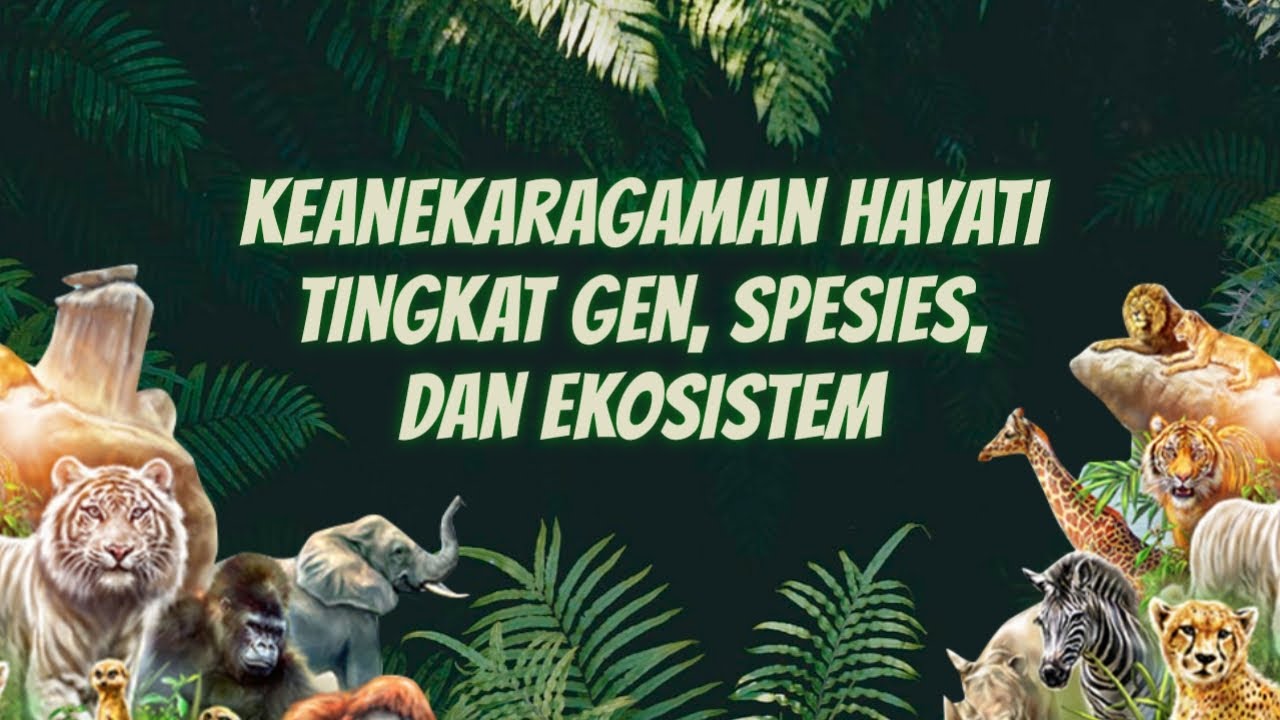Kelas 10 SMA - Biologi - Keanekaragaman Hayati - Bimbel Tridaya Online
Summary
TLDRThis biology tutorial covers the concept of biodiversity, explaining its three levels: genetic, species, and ecosystem diversity. It delves into the distribution of fauna in Indonesia, exploring the Oriental, transitional, and Australis regions, with examples of unique animal species. The video also discusses the distribution of flora in the Malesiana region and highlights conservation efforts, differentiating between in-situ (on-site) and ex-situ (off-site) methods. A comprehensive guide to understanding the complexity of biodiversity, its geographical spread, and conservation strategies in Indonesia.
Takeaways
- 😀 Biodiversity refers to the variety of life in the world, including genetic, species, and ecosystem diversity.
- 😀 Genetic diversity involves variations within the same species, such as differences in rose colors (e.g., red and white roses).
- 😀 Species diversity refers to variations within the same genus or family, like the various types of cats (house cats, tigers, lions).
- 😀 Ecosystem diversity involves different environments and interactions between living organisms and their habitats, like wetlands or marine ecosystems.
- 😀 The fauna distribution in Indonesia is divided into three regions: Oriental, Transition, and Australasian, each with distinct species.
- 😀 The Oriental region includes islands like Sumatra, Java, and Kalimantan, and features large mammals such as elephants and tigers.
- 😀 The Transition region covers Sulawesi and Nusa Tenggara and is known for species like the Komodo dragon and the anoa.
- 😀 The Australasian region, which includes parts of Indonesia and Australia, is home to unique animals like kangaroos and birds of paradise.
- 😀 Global fauna is distributed across six major regions: Palaearctic, Nearctic, Neotropical, Ethiopian, Oriental, and Australasian.
- 😀 Flora distribution in Indonesia is part of the Malesian region, which also includes Malaysia, the Philippines, and Papua New Guinea.
- 😀 Conservation efforts are classified into two types: in-situ (conservation within natural habitats) and ex-situ (conservation outside natural habitats, like botanical gardens and zoos).
Q & A
What are the three levels of biodiversity?
-The three levels of biodiversity are genetic diversity, species diversity, and ecosystem diversity. Genetic diversity refers to the variety of genes within a species, species diversity refers to the variety of species within a group, and ecosystem diversity refers to the variety of ecosystems in an area.
How does genetic diversity differ from species diversity?
-Genetic diversity refers to the variations in genes within a single species, whereas species diversity involves the differences between different species within a genus or family. Genetic diversity looks at variations within a species, while species diversity compares different species.
Can you give examples of genetic diversity in nature?
-Examples of genetic diversity include variations in the color of roses (red, white, yellow), and human differences such as skin color, eye color, and hair type, even though all belong to the same species.
What is meant by species diversity, and how can it be observed?
-Species diversity refers to the variety of different species within a genus or family. It can be observed through the morphological, anatomical, or physiological differences among species. For example, in the Felidae family, there are cats, lions, tigers, and other big cats, all differing in size, fur, and behavior.
What are the three main regions of faunal distribution in Indonesia?
-The three main regions of faunal distribution in Indonesia are the Oriental region, the Transitional region, and the Australasian region. These regions have distinct animal species, such as tigers and elephants in the Oriental region, Komodo dragons in the Transitional region, and kangaroos in the Australasian region.
What animals are commonly found in the Oriental faunal region of Indonesia?
-In the Oriental region of Indonesia, animals like tigers, elephants, orangutans, and various species of primates such as macaques and gibbons can be found.
What is the significance of Wallace's Line in Indonesia’s faunal distribution?
-Wallace's Line is the boundary that separates the fauna of the Oriental and Australasian regions. It marks the distinct difference in species found in Indonesia, with animals like tigers and elephants to the west (Oriental) and marsupials like kangaroos and wallabies to the east (Australasian).
What are some notable plant species from Indonesia's Malesiana flora region?
-Notable plant species from the Malesiana flora region include Rafflesia arnoldii (found in Bengkulu), jati trees (found in Java), and the Irian flower (found in Papua).
What is the difference between in-situ and ex-situ conservation methods?
-In-situ conservation refers to protecting species in their natural habitats, such as in national parks or wildlife sanctuaries. Ex-situ conservation involves preserving species outside of their natural habitats, such as in botanical gardens, zoos, or gene banks.
Can you give examples of in-situ conservation areas in Indonesia?
-Examples of in-situ conservation areas in Indonesia include national parks like Way Kambas and Ujung Kulon, as well as wildlife sanctuaries and nature reserves that aim to protect species in their natural environments.
Outlines

هذا القسم متوفر فقط للمشتركين. يرجى الترقية للوصول إلى هذه الميزة.
قم بالترقية الآنMindmap

هذا القسم متوفر فقط للمشتركين. يرجى الترقية للوصول إلى هذه الميزة.
قم بالترقية الآنKeywords

هذا القسم متوفر فقط للمشتركين. يرجى الترقية للوصول إلى هذه الميزة.
قم بالترقية الآنHighlights

هذا القسم متوفر فقط للمشتركين. يرجى الترقية للوصول إلى هذه الميزة.
قم بالترقية الآنTranscripts

هذا القسم متوفر فقط للمشتركين. يرجى الترقية للوصول إلى هذه الميزة.
قم بالترقية الآنتصفح المزيد من مقاطع الفيديو ذات الصلة

Materi KEANEKARAGAMAN HAYATI: Materi SMA | Part 1

Keanekaragaman Hayati Tingkat Gen, Spesies, dan Ekosistem | Dunia Biologi

Tingkat Keanekaragaman Hayati | Biologi Kelas X

Biodiversity (Grade 9)

Keanekaragaman Hayati | Belajar online mapel biologi

KEANEKARAGAMAN HAYATI #part 1 | X IPA BIOLOGI | KURIKULUM MERDEKA
5.0 / 5 (0 votes)
